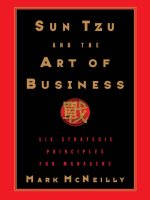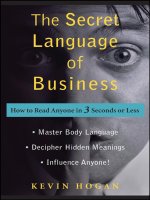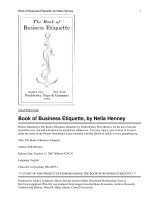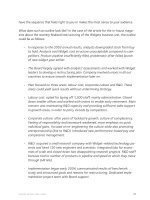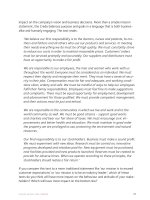The blessings of business how corporations shaped conservative christianity
Bạn đang xem bản rút gọn của tài liệu. Xem và tải ngay bản đầy đủ của tài liệu tại đây (13.3 MB, 305 trang )
www.ebook3000.com
The Blessings of Business
www.ebook3000.com
The Blessings of Business
How Corporations Shaped
Conservative Christianity
DARREN E. GREM
1
1
Oxford University Press is a department of the University of Oxford. It furthers
the University’s objective of excellence in research, scholarship, and education
by publishing worldwide. Oxford is a registered trade mark of Oxford University
Press in the UK and certain other countries.
Published in the United States of America by Oxford University Press
198 Madison Avenue, New York, NY 10016, United States of America.
© Oxford University Press 2016
All rights reserved. No part of this publication may be reproduced, stored in
a retrieval system, or transmitted, in any form or by any means, without the
prior permission in writing of Oxford University Press, or as expressly permitted
by law, by license, or under terms agreed with the appropriate reproduction
rights organization. Inquiries concerning reproduction outside the scope of the
above should be sent to the Rights Department, Oxford University Press, at the
address above.
You must not circulate this work in any other form
and you must impose this same condition on any acquirer.
Library of Congress Cataloging-in-Publication Data
Names: Grem, Darren E., author.
Title: The blessings of business: how corporations shaped conservative Christianity / Darren E. Grem.
Description: New York: Oxford University Press, 2016. | Includes bibliographical references and index.
Identifiers: LCCN 2015044390 (print) | LCCN 2016007190 (ebook) |
ISBN 978–0–19–992797–5 (cloth: alk. paper) | ISBN 978–0–19–992798–2 (updf) |
ISBN 978–0–19–046700–5 (epub)
Subjects: LCSH: United States—Church history—20th century. | Business—Religious aspects—
Christianity. | Conservatism—Religious aspects—Christianity. | Conservatism—United States—History—
20th century. | Evangelicalism—United States—History—20th century.
Classification: LCC BR517.G74 2016 (print) | LCC BR517 (ebook) | DDC 261.8/50973—dc23
LC record available at />1 3 5 7 9 8 6 4 2
Printed by Sheridan, USA
www.ebook3000.com
For W. Ellie and Phyllis C. Grem
www.ebook3000.com
CONTENTS
Acknowledgments
Abbreviations xiii
Introduction
ix
1
PART I HOW BIG BUSINESSMEN SHAPED
CONSERVATIVE EVANGELICALISM
1. Fundamentalist Fronts: Herbert J. Taylor, Businessmen,
and the “Revival” of Conservative Evangelicalism 13
2. Corporate Convictions: Billy Graham, Big Business,
and the New Evangelicalism 49
3. Corporate Crusades: Markets, Missions, and R. G. LeTourneau’s
Cold War 82
PART II HOW CONSERVATIVE EVANGELICALISM
BECAME BIG BUSINESS
4. Marketplace Missions: Chick-fil-A and the Evangelical
Business Sector 121
5. Culture Industries: Heritage USA and the Corporatization
of Evangelical Culture 162
vii
Contents
viii
6. Free-╉Market Faith: Zig Ziglar and the Business of Evangelical
Culture Warâ•… 192
Conclusionâ•…
Notesâ•…
Indexâ•…
226
239
267
www.ebook3000.com
ACKNOWLEDGMENTS
My immediate family deserves the first round of thanks. W. Ellie and Phyllis
C. Grem always said that an education is the one of the few things in life that no
one can take from you. They stood by that belief and sacrificed more than they
should have to make sure I took their lesson to heart. They have been supportive
beyond words from preschool through graduate school, and they have shaped
my life in ways I am only beginning to realize. This book is for them. I also appreciate the love and support of my siblings Marty and Joy, both of whom have
taught me that not every part of your education happens in a classroom. My
children, Will and Lily, have done much the same. They are already an inspiration, convincing me each day that parenthood is a far richer challenge than any
academic or professional endeavor I will undertake.
At the University of Georgia, Jim Cobb offered wise counsel through several
dead ends and false starts, pushing me to be as ambitious as possible. He called
it like he saw it, and I would never want him to do otherwise. I hope all the
“hunkering down” was worth it. John Inscoe saw me through my first research
seminar and my first published article. He also asked some great questions at
various stages of the research and writing process, and I thank him for the advice
he offered over many a free lunch. Laura Mason likewise taught me how to think
about whose stories are untold in history and inspired me to think harder about
the nature of power and the broad ramifications of the seemingly mundane.
Bethany Moreton and I met one another just as the project was getting underway, but she offered help and encouragement when most needed. Similarly,
Theo Calderara at Oxford University Press saw promise in the project from the
start and let it take shape as it did. His editorial guidance took it from dissertation to manuscript to book, and I appreciate his suggestions and patience.
Archivists at libraries and colleges from Delaware to North Carolina to
Illinois to Texas made the research go as smoothly as possible, but I reserve
special thanks for the folks at LeTourneau University and the Hagley Library
ix
x
A ck nowl edg ments
and Museum for bringing several items to my attention that I would not have
otherwise had the pleasure of finding. Many friends and colleagues also made
this project better, or at least made the process more rewarding. Jenna Mason
supported the project for many years, and I thank her for sacrificing in small
and big ways so it could find its way to completion. I also single out John Hayes,
Tore Olsson, Mike Altman, and Luke Harlow for their friendship and scholarly support. I cherish the many conversations we’ve had over numerous beers
and lunches. Lloyd Benson was first my history professor way back at Furman
University, but I now count him as a friend and fellow historical adventurer.
Many thanks for convincing me to rethink a life in advertising.
Many other co-travelers and colleagues at the University of Georgia
took an active interest in the project or just lent an ear, including Rhiannon
Evangelista, Ichiro Miyata, Daleah Goodwin, Bruce Stewart, Chris
Manganiello, Robby Luckett, Tom Okie, Blake Scott, Barton Myers, Chris
Huff, and Derek Bentley. Back-to-back postdoctoral appointments at Yale
University and Emory University helped sharpen the project. I thank the Yale
Center for Faith and Culture and Fox Center for Humanistic Inquiry for providing the time and office space to write and think, as well as the chance to
meet and work with the likes of Angie Heo, Alan Hurst, Elizabeth Bouldin,
Miroslav Volf, Ted Malloch, the late Randy Strahan, and Roberto Franzosi.
I also thank Cambridge University Press and the University of Pennsylvania
Press for permission to reprint excerpts from previously published versions
of chapter 2 and chapter 4.
In the Arch Dalrymple III Department of History at the University of
Mississippi, colleagues like Jesse Cromwell, John Ondrovcik, Anne Twitty,
Deirdre Cooper Owens, Charles Eagles, Jarod Roll, Marc Lerner, Joe Ward,
Sue Grayzel, April Holm, Mikaëla Adams, Vivian Ibrahim, Oliver Dinius, Will
Hustwit, John Neff, Jeff Watt, and Elizabeth Payne made the transition to Oxford
an easy one. At the Center for the Study of Southern Culture, I thank Charles
Reagan Wilson, Katie McKee, Jimmy Thomas, Simone Delerme, Jodi Skipper,
Barb Combs, Mary Hartwell Howorth, Becca Walton, and Ted Ownby for the
hospitality and encouragement. For scholarly companionship and support, I also
thank Phil Sinitiere, Clay Howard, Ben Wise, Steven Miller, Ian Lekus, Paul Sutter,
Bryan Simon, Pamela Voekel, Matt Sutton, Randall Stephens, Eileen Luhr, Rob
Riser, Darren Dochuk, Michelle Nickerson, Molly Worthen, Matt Lassiter, Joe
Crespino, Kevin Kruse, Grant Wacker, Ed Blum, the late Sarah Ruth Hammond,
Katie Lofton, David King, Tim Gloege, J. T. Thomas, Matt Bowman, Elesha
Coffman, Elizabeth and Ken Fones-Wolf, and John Turner. Kelly J. Baker and
Paul Harvey welcomed me on the “blog staff ” at Religion in American History,
and I thank them for allowing me such a forum to make the online acquaintance
www.ebook3000.com
A ck nowl edg ment s
xi
of fellow historians and lay out my random thoughts on religion, politics, and
SEC football.
Last but certainly not least, I wish to thank the Drive-By Truckers, among
many other talented and insightful bands, for getting me through countless hours
of writing and rewriting. The roads wind as they do, but I’ll keep it between the
ditches.
www.ebook3000.com
A B B R E V I AT I O N S
BOH Baylor Institute for Oral History, Waco, Texas
CTR Christianity Today Collection, Billy Graham Center Archives,
Wheaton, IL
DPL Religious Periodicals Collection, Dallas Public Library, Dallas, TX
FFR The Fellowship Foundation Collection, Billy Graham Center Archives,
Wheaton, IL
FPC Flower Pentecostal Heritage Center, Springfield, MO
HJT Herbert J. Taylor Collection, Billy Graham Center Archives,
Wheaton, IL
IVF Intervarsity Christian Fellowship Collection, Billy Graham Center
Archives, Wheaton, IL
JHP J. Howard Pew, Personal Papers, Hagley Museum and Library,
Wilmington, DE
LET LeTourneau Family Archives, LeTourneau University, Longview, TX
NAV The Navigators Papers, Billy Graham Center Archives, Wheaton, IL
RLP Roy Lundquist Papers, Billy Graham Center Archives, Wheaton, IL
UGA Hargrett Rare Books and Manuscripts Library, University of Georgia,
Athens, GA
VWP Vernon W. Patterson Collection, Billy Graham Center Archives,
Wheaton, IL
WBT Wycliffe Bible Translators Archives, JAARS, Waxhaw, NC
ZIG Zig Ziglar Papers, Southern Baptist Convention Archives,
Nashville, TN
xiii
www.ebook3000.com
The Blessings of Business
www.ebook3000.com
Introduction
On a sunny July morning in 1952, evangelist Billy Graham slipped on a pair
of sunglasses and stepped onto a platform along the banks of the Mississippi
River. He raised his eyes toward heaven and asked God to bless a 200-foot-long
cargo ship.
The ship was bound for Liberia, and R. G. LeTourneau, a multimillionaire
and one of the world’s leading manufacturers of heavy earthmoving equipment,
had invited Graham to Vicksburg, Mississippi, for the occasion. “The Ark of
LeTourneau,” as locals called it, contained 500 copies of the New Testament, a
dozen “technical missionaries,” and a half-million dollars’ worth of LeTourneau’s
wares. LeTourneau was flying ahead to Liberia shortly after the ceremony “to be
there when the boat rams that beach.”
A year earlier, LeTourneau had signed a contract with the Liberian government granting him a lease on half a million acres of land. His “technical missionaries” would clear surrounding jungles, using a portable sawmill hauled by
the largest bulldozer in the world and a 22-ton machine that could reportedly
“shear off big trees like a scythe cutting grass.” LeTourneau would sell the harvested timber and use the newly cleared land to cultivate rice, grapefruit, banana,
and palm trees for export. For the first five years, all profits would be poured
back into the mission. Graham applauded LeTourneau’s decisiveness, encouraging “more business men to follow in the footsteps of R. G. LeTourneau in
making Christianity a part of their businesses and everyday lives.” LeTourneau
told a reporter for Time that he was merely “trying to do a missionary job in a
businesslike way.”1
Graham saw the invitation as a chance to repay a debt. Born in North Carolina,
Graham had turned to revivalism and preaching after a brief stint as a salesman
for the Fuller Brush Company. After attending Wheaton College, a conservative evangelical school outside Chicago, Graham took a pastoral position before
signing on with Youth for Christ (YFC), then a fledgling ministry for teenagers
and young adults. In 1946, while Graham was working for YFC, LeTourneau
gave $7,000 (nearly $90,000 in today’s dollars) to help fund an evangelistic tour
1
2 I n t r o d u c t i o n
of Ireland (See Fig. I.1). That was YFC’s and Graham’s business strategy in a
nutshell: join the fortunes of big donors to the meager offerings of small donors
to expand the horizons of conservative Christianity.2
Such a strategy was common in evangelical circles at mid-century. Executives
underwrote numerous evangelical organizations, quite a few of them in Graham’s
orbit: Christianity Today magazine, the National Association of Evangelicals,
Young Life, Intervarsity Christian Fellowship, Wycliffe Bible Translators, The
Navigators, and Campus Crusade for Christ. But executives also brought conservative Christianity directly into the corporate world, shaping companies that
were—as born-again businessman Marion E. Wade of ServiceMaster put it—
“dedicated” to the Lord’s service. Their approaches varied, but each executive
Figure I.1 Industrialist R. G. LeTourneau (left) with evangelist Billy Graham (right) in
1968. Courtesy of Longview News-Journal.
www.ebook3000.com
Int roduc tion
3
viewed business as a religious arena and endeavor. The world of private enterprise, it seemed, had many blessings to offer their faith—and vice versa.
With the help of people, methods, institutions, and money from corporate
America, conservative evangelicals believed that they could advance a religious,
social, and political revolution. They could spark mass revival. They could fund
schools and promote new ways of thinking. They could mold the next generation of young believers, defining what it meant to live and work as a modern, cosmopolitan, world-changing Christian. They could inspire others to work hard,
knowing that their work was favored by God. They could create media empires
and become national celebrities. They could become members of the nation’s
economic and political elite. Blessed by business, conservative evangelicals
believed that they could and would have a hand in the history of nations.
This book tells the stories of the businessmen and businesses behind one
of the longest-running and most important social and religious movements of
the twentieth century.3 These stories have gone largely untold in most considerations of conservative Christianity’s place in modern American history. To be
sure, much has been written on the role of evangelical leaders in giving voice to
the millions of ordinary believers who served as the grassroots base for conservative candidates throughout the twentieth century.4 But focusing on prominent
leaders or grassroots activists, or just their political aspirations and election season efforts, does not account for what Graham sought from LeTourneau, what
LeTourneau offered Graham in return, or what LeTourneau thought about his
own identity as a self-proclaimed “Christian businessman.” It does not account
for the fact that conservative evangelicalism was formed in boardrooms and private businesses, not just in churches or communities or during political campaigns. It does not account for corporate elites from across the denominational
and political spectrum or for countless business decisions. And, most important,
it does not account for billions upon billions of dollars.
Every successful movement requires money, and big businessmen used their
money—as well as their ideas, values, and organizations—to make and remake
conservative evangelicalism in profound and enduring ways.5 Corporate involvement in conservative evangelicalism did not begin, as is usually believed, in the
lead-up to the presidential election of 1980.6 Collaborations between conservative evangelicals, corporate benefactors, and businesses started around the turn
of the twentieth century. For the next fifty years, through a Great Depression,
Second World War, and early Cold War, evangelicals, Christian businessmen,
and nonevangelical business leaders continued to work together. Similarly, in
the 1960s and 1970s, business interests and elites persisted in molding conservative evangelicalism in their own image, building on the investments made in previous decades and spreading their brand of evangelical religion into new sectors
of private and public life. Politics was one such sector, and an important one at
4 I n t r o d u c t i o n
that, but historians have largely overlooked the parallel story of how evangelical
Christianity became both a business-friendly religion and a profitable form of
corporate capitalism, with notable implications for business culture, religious
culture, and politics in modern America.
How did the alliance between conservative evangelicals and big business
come about? In the late nineteenth century, with their grip on the social and
political direction of the country loosening, evangelicals realized that the corporation was becoming an important American institution and the corporate elite
an untapped source of financial and social capital. To be sure, plenty of working-
class and heartland evangelicals were disturbed by the new corporate leviathan
and the power it seemed to have over their lives.7 But other evangelicals were
heartened, even excited. To work through business for the “revival” and advancement of their gospel was a new way to be a Christian. As LeTourneau put it, “We
are going to sell laymen the idea that they are going to work for Jesus Christ
seven days of the week or not call themselves Christians.”8 This quip, delivered
in 1941 before a captive audience of “Christian laymen,” shows how conservative evangelicals had come to see the corporation by World War II. It was a place
where their visions of proper and legitimate “religion” could and should flourish.
Over the rest of the twentieth century, evangelicals built a private-sector
infrastructure of money, businesses, institutions, philanthropies, and patronage that crisscrossed the country from Chicago to Los Angeles to New York to
Dallas to Atlanta and beyond. Particular places mattered, but only insofar as they
nurtured local enterprises that went regional or national or transnational—or
connected evangelicals and business elites to larger social and financial networks. This was not, in other words, a phenomenon restricted to the so-called
Bible Belt. Though places in the South, especially after World War II, certainly
shaped conservative evangelicalism, corporate centers in the North, such as
Chicago, and the Southwest, such as southern California, mattered as well, and
often mattered more.9
Conservative evangelicals did more than shape, or strive to shape, the nation’s
religious, cultural, or political marketplace. They were proactive and strategic
about leaving their mark on actual market places. In their crusades to garner
elite support or create and sustain various business enterprises, conservative
evangelicals devised interpretations of work and religious visions of public life
that proved attractive inside and outside the evangelical fold. Evangelicals were
also strewn throughout boardrooms, suburban shopping malls, and commercial strips; present at self-styled “Christian” radio stations, stores, and publishing
houses; and working as managers of a wide range of businesses.10 Evangelicals
had expansive corporate headquarters and set up million-dollar monuments
to business success. They founded and ran a Christian theme park and resort,
and they sold Christian goods and services to fellow evangelicals and other
www.ebook3000.com
Int roduc tion
5
customers. Evangelicals made it, with the help of business ideas and capital—
or as businessmen themselves—into Manhattan office buildings and the halls
of power in Washington, D.C. Thanks to corporate sponsors, conservative
evangelicals became national and international celebrities, routinely preaching
defenses of meritocratic work to packed crowds in sports stadiums and working
to push a dual program of “free enterprise” and “family values” in companies and
Congress.
Through their business pursuits, evangelicals also became intertwined with
the nation’s federal bureaucracy. Scholars have long ascribed the federal government a central role in twentieth-century American life. But the state has only
just begun to make it into the main narrative of modern American religious history. Indeed, one of the most notable and perhaps unexpected shapers of the
evangelical business landscape was the very government that businessmen often
claimed was standing in their way. Scholars have largely affirmed that narrative.
They have cast evangelicals as growing over the course of the century in their
opposition to federal activities or policies, becoming along with other conservatives the state’s foremost critics and antagonists. This characterization is not
altogether wrong. The evangelical-inflected, regulatory “moral establishment”—
resulting in federal Prohibition, for instance, or in countless local and state laws
regulating individual personal behavior and public “morality”—crumbled in the
mid-to late twentieth century, in large part due to court decisions and political
opposition to evangelical power in local and federal politics, customs, and law.
And evangelicals did not take such changes lightly.11
But in several quieter—though no less important—ways, the state continued to endorse evangelical activities (and continues to do so today). As much
as evangelicals might rail against it, the federal government was an ally of business-minded and business-backed believers hoping to assert their religious,
racial, gendered, and economic authority. This went beyond evangelical-supported state rituals and proclamations, in full bloom at mid-century, linking an
“American Way of Life” to the nation’s “Judeo-Christian” heritage or status as
“One Nation Under God.”12 Sometimes, state officials directly supported evangelical businesses via private–public partnerships. For instance, LeTourneau
owed his spiritual and economic “development” plans not only to up-from-the-
bootstraps effort but to contracts for a wide variety of public works projects.
Likewise, during and after World War II, LeTourneau benefitted from a private–
public partnership with the military, to which his company provided thousands
of bulldozers, scrapers, and pullers. State support translated abroad during the
early Cold War, as foreign governments opened to outside corporatization,
including but not limited to LeTourneau’s cadre of “technical missionaries.”
The marketplace missions of evangelicals also received indirect government support through the tax code. Evangelical philanthropies, many started or
6 I n t r o d u c t i o n
underwritten by businessmen, enjoyed freedom from taxation, as did churches,
parachurch organizations, and publications, to which believers could make tax-
deductible contributions. At other times, legislation or Supreme Court decisions enabled conservative evangelicalism, especially in the private sector. For
instance, Title VII of the Civil Rights Act of 1964, a provision that barred religious discrimination in the workplace, allowed room for conservative evangelicals to bring their religious beliefs to bear on workplace cultures, both in large
corporations and in thousands of smaller businesses that tied evangelical influence to monthly and quarterly profits. The state, therefore, was yet another contributor to the corporate landscape of conservative evangelicalism.
Business leaders and elites also shaped the faith’s ideological makeup, sometimes in surprising ways. Contrary to the fire-and-brimstone preachers and
leaders who became, especially in the late 1970s and 1980s, the public image of
evangelical politics, evangelical business leaders often displayed a strategic ecumenism and penchant for moderation, emphasizing a rational, plodding pragmatism that, they thought, might broaden their appeal. Moreover, evangelical
business elites often appropriated ideas from progressives, positive thinkers, and
the counterculture when constructing what it meant to conduct “Christian business.” From as early as the 1930s, evangelical businessmen argued for the freedom to run their enterprises as they wished, based in a managerial philosophy
of executive purpose, corporate responsibility, or social “service” borrowed, in
part, from more progressive Protestant circles and management theorists. In the
1970s, evangelicals like motivational speaker Zig Ziglar blended positive thinking with Christian revivalism, whooping it up for corporate free enterprise. Mary
Kay Ash, founder of Mark Kay Cosmetics and one of the few female executives
of note, reinterpreted women’s liberation as the right of evangelical women to
work for the sake of God, family, and nation. In evangelical consumer culture,
countercultural styles redefined what it meant to be a conservative Christian
consumer and citizen. To be sure, the faith was a conservative one, and big business sometimes underwrote radical forms of right-wing evangelicalism. But conservative evangelical businessmen and enterprises often borrowed from the left
while simultaneously opposing it.
The stories that follow afford a final insight. Historian Kim Phillips-Fein
recently noted that historians have only just started to avoid the tendency, common in scholarly or popular discourse, of “read[ing] conservatism’s successes
backward through postwar history.” Assessing where conservatives won and lost
certainly becomes clearer when considering evangelical cultural and political
ventures through the lens of business history.13 While businesses were important vehicles for evangelical aspirations, activism, and engagement, the blessings
of business were often mixed. A number of business-backed evangelistic experiments floundered or failed. LeTourneau’s venture in Liberia, for example, was
www.ebook3000.com
Int roduc tion
7
a mess, underfunded and poorly executed. His “technical missionaries” faced
innumerable logistical obstacles and unforeseen setbacks. By 1966, despite sinking hundreds of thousands of dollars into it, LeTourneau considered the project
a bust. When he died three years later, his foreign ventures were already largely
forgotten by history.14
LeTourneau’s experience was not necessarily common, but it was common enough to provide a counternarrative to the seemingly inevitable “rise”
of conservative evangelicalism, whether one dates that rise to the 1930s or to
a post-1960s “backlash.” Though they aimed for broad public influence, evangelicals’ work through private means—individual donors, the private sector,
and corporations—often reaffirmed their parochialism. That is not to say that
the evangelicals’ corporate endeavors ultimately led to their full-scale marginalization in American public life. It clearly did not. Thanks in part to big business, conservative evangelicals secured billions of dollars for their movement
and fixed themselves to corporations large and small. They also won a perennial
place in American politics and in the American political establishment via, for
instance, inside-the-beltway lobbying groups. But as a religion and social movement routinely framed and funded by big business, by the end of the twentieth
century conservative evangelicalism was also surprisingly insular, diffuse, and
limited. It was insular because many evangelicals experienced their faith in privatized settings, especially in privately owned businesses. It was diffuse because
those settings and businesses were scattered across the country. And it was limited because many arenas of American public life remained—despite a century
of corporate empowerment—relatively unaffected by conservative evangelical
activities.
This book is divided into two parts, each of which deals with a particular type
of collaboration between corporate executives, corporate culture, corporate
money, corporate methods, and conservative evangelicalism. Part I focuses on
the 1920s through the 1960s, revealing how big businessmen aided conservative evangelicals’ attempts to remake, sustain, and extend their religious identity, authority, and influence in modern American life. Part II focuses on the
1960s through the 1990s, detailing what evangelicals did through the private
sector by developing—or striving to develop—large-scale business enterprises.
Each chapter focuses on specific moments and agents of what I call “corporate
revival.” In other words, each chapter details a particular manifestation of corporate influence at a given point in modern evangelical history.
My purpose with this book is threefold. First, I show how corporations shaped
conservative Christianity into its many private and public forms. Thus, the stories that follow should foment critical discussions about the reach and limits
of corporate power in the American past and present. Today, corporate elites
enjoy a certain measure of anonymity, and there are few historical roadmaps for
8 I n t r o d u c t i o n
understanding their exact influence on American culture and politics. This book
addresses this problem by uncovering and evaluating the actions of people too
often hidden at the top: corporate executives, elites, and the organizations and
the religions, cultures, and popular movements they have made or tried to shape.
In doing so, however, I do not attribute undue influence to big business or corporate elites; neither do I offer a celebratory saga of corporate beneficence or
a conspiratorial tale of well-planned and well-coordinated corporate empowerment. What follows is a history of corporate power that takes variety, contingency, and conflict into account.15
Second, I shed light on the business side of modern American religion, religious culture, and religious politics. In a nation where the corporation and the
state became critical shapers of the self, community, and racial, social, economic,
and political orders, the business of American religion is too often overlooked.
In and through corporate America, conservative evangelicals defined and
redefined themselves and attempted to stake their claim on American society.
If nothing else, then, the stories that follow are fitting rebukes to the common
evangelical impulse to cast themselves as marginalized, victimized, oppressed
figures in American history. Such an interpretation of the past—or present—
might be vital for evangelicals’ sense of embattlement, but it does not accord
with the historical record. Business, often big business, mediated by the state,
played a key role in shaping conservative evangelicalism.16
My third purpose is to place the processes of religious construction within
the history of American corporate capitalism. The private sector has been a
crucial venue and means by which Americans articulate what it means—and
does not mean—to be “religious.” Indeed, corporate elites, businesses, and their
money shaped the meaning of “conservative evangelical” itself. To be a “conservative” type of “evangelical” or—as they more routinely called themselves—a
“Christian” came to mean that one embraced the American business elite,
engaged in business-making, and worked out one’s religious identity through
corporate work, buying patterns, and consumerism. This crowded out other
definitions of “evangelical” and “Christian” that might have made more room
for, say, working-class concerns or challenges to white privilege and patriarchy.
That evangelical progressives struggled to become more than moral minorities
in modern America was not merely a matter of failures in persuasion or political
strategy. It was a matter of money, power, strategy, and appropriation.17
It was also a matter of linking conservative evangelicalism to market
exchanges. Millions of American consumers, regardless of their particular faith
commitments, played a role in the development and consolidation of conservative evangelicalism’s place in modern America. They did so, often unknowingly, when they came into contact with evangelical businesses or businesses
run or managed by evangelicals. Dollars that went into such businesses from
www.ebook3000.com
